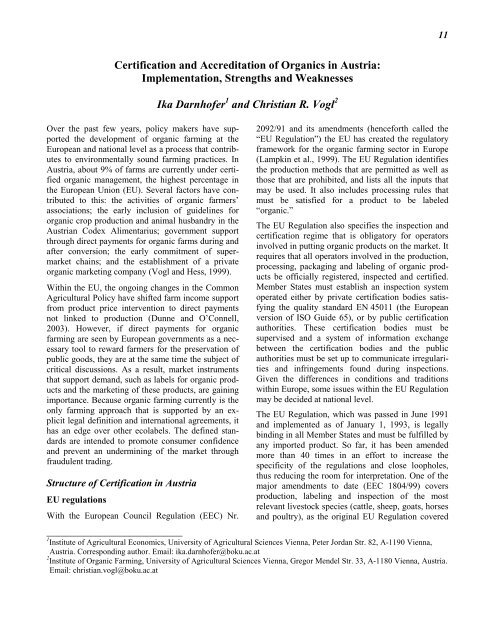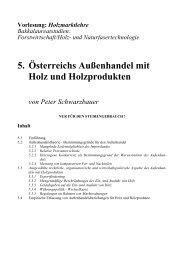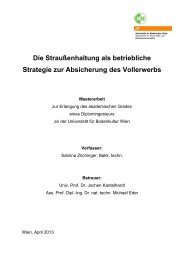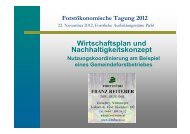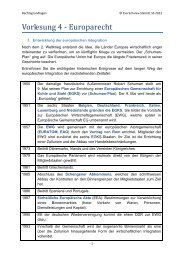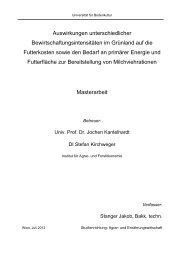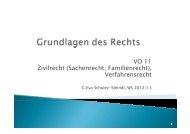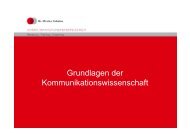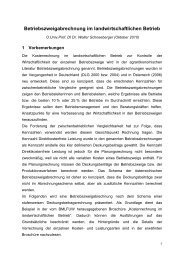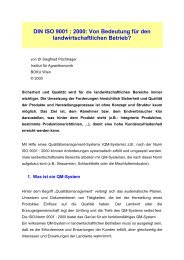Certification and Accreditation of Organics in Austria - Boku
Certification and Accreditation of Organics in Austria - Boku
Certification and Accreditation of Organics in Austria - Boku
You also want an ePaper? Increase the reach of your titles
YUMPU automatically turns print PDFs into web optimized ePapers that Google loves.
<strong>Certification</strong> <strong>and</strong> <strong>Accreditation</strong> <strong>of</strong> <strong>Organics</strong> <strong>in</strong> <strong>Austria</strong>:<br />
Implementation, Strengths <strong>and</strong> Weaknesses<br />
Over the past few years, policy makers have supported<br />
the development <strong>of</strong> organic farm<strong>in</strong>g at the<br />
European <strong>and</strong> national level as a process that contributes<br />
to environmentally sound farm<strong>in</strong>g practices. In<br />
<strong>Austria</strong>, about 9% <strong>of</strong> farms are currently under certified<br />
organic management, the highest percentage <strong>in</strong><br />
the European Union (EU). Several factors have contributed<br />
to this: the activities <strong>of</strong> organic farmers’<br />
associations; the early <strong>in</strong>clusion <strong>of</strong> guidel<strong>in</strong>es for<br />
organic crop production <strong>and</strong> animal husb<strong>and</strong>ry <strong>in</strong> the<br />
<strong>Austria</strong>n Codex Alimentarius; government support<br />
through direct payments for organic farms dur<strong>in</strong>g <strong>and</strong><br />
after conversion; the early commitment <strong>of</strong> supermarket<br />
cha<strong>in</strong>s; <strong>and</strong> the establishment <strong>of</strong> a private<br />
organic market<strong>in</strong>g company (Vogl <strong>and</strong> Hess, 1999).<br />
With<strong>in</strong> the EU, the ongo<strong>in</strong>g changes <strong>in</strong> the Common<br />
Agricultural Policy have shifted farm <strong>in</strong>come support<br />
from product price <strong>in</strong>tervention to direct payments<br />
not l<strong>in</strong>ked to production (Dunne <strong>and</strong> O’Connell,<br />
2003). However, if direct payments for organic<br />
farm<strong>in</strong>g are seen by European governments as a necessary<br />
tool to reward farmers for the preservation <strong>of</strong><br />
public goods, they are at the same time the subject <strong>of</strong><br />
critical discussions. As a result, market <strong>in</strong>struments<br />
that support dem<strong>and</strong>, such as labels for organic products<br />
<strong>and</strong> the market<strong>in</strong>g <strong>of</strong> these products, are ga<strong>in</strong><strong>in</strong>g<br />
importance. Because organic farm<strong>in</strong>g currently is the<br />
only farm<strong>in</strong>g approach that is supported by an explicit<br />
legal def<strong>in</strong>ition <strong>and</strong> <strong>in</strong>ternational agreements, it<br />
has an edge over other ecolabels. The def<strong>in</strong>ed st<strong>and</strong>ards<br />
are <strong>in</strong>tended to promote consumer confidence<br />
<strong>and</strong> prevent an underm<strong>in</strong><strong>in</strong>g <strong>of</strong> the market through<br />
fraudulent trad<strong>in</strong>g.<br />
Structure <strong>of</strong> <strong>Certification</strong> <strong>in</strong> <strong>Austria</strong><br />
EU regulations<br />
With the European Council Regulation (EEC) Nr.<br />
Ika Darnh<strong>of</strong>er 1 <strong>and</strong> Christian R. Vogl 2<br />
____________________________<br />
1 Institute <strong>of</strong> Agricultural Economics, University <strong>of</strong> Agricultural Sciences Vienna, Peter Jordan Str. 82, A-1190 Vienna,<br />
<strong>Austria</strong>. Correspond<strong>in</strong>g author. Email: ika.darnh<strong>of</strong>er@boku.ac.at<br />
2 Institute <strong>of</strong> Organic Farm<strong>in</strong>g, University <strong>of</strong> Agricultural Sciences Vienna, Gregor Mendel Str. 33, A-1180 Vienna, <strong>Austria</strong>.<br />
Email: christian.vogl@boku.ac.at<br />
11<br />
2092/91 <strong>and</strong> its amendments (henceforth called the<br />
“EU Regulation”) the EU has created the regulatory<br />
framework for the organic farm<strong>in</strong>g sector <strong>in</strong> Europe<br />
(Lampk<strong>in</strong> et al., 1999). The EU Regulation identifies<br />
the production methods that are permitted as well as<br />
those that are prohibited, <strong>and</strong> lists all the <strong>in</strong>puts that<br />
may be used. It also <strong>in</strong>cludes process<strong>in</strong>g rules that<br />
must be satisfied for a product to be labeled<br />
“organic.”<br />
The EU Regulation also specifies the <strong>in</strong>spection <strong>and</strong><br />
certification regime that is obligatory for operators<br />
<strong>in</strong>volved <strong>in</strong> putt<strong>in</strong>g organic products on the market. It<br />
requires that all operators <strong>in</strong>volved <strong>in</strong> the production,<br />
process<strong>in</strong>g, packag<strong>in</strong>g <strong>and</strong> label<strong>in</strong>g <strong>of</strong> organic products<br />
be <strong>of</strong>ficially registered, <strong>in</strong>spected <strong>and</strong> certified.<br />
Member States must establish an <strong>in</strong>spection system<br />
operated either by private certification bodies satisfy<strong>in</strong>g<br />
the quality st<strong>and</strong>ard EN 45011 (the European<br />
version <strong>of</strong> ISO Guide 65), or by public certification<br />
authorities. These certification bodies must be<br />
supervised <strong>and</strong> a system <strong>of</strong> <strong>in</strong>formation exchange<br />
between the certification bodies <strong>and</strong> the public<br />
authorities must be set up to communicate irregularities<br />
<strong>and</strong> <strong>in</strong>fr<strong>in</strong>gements found dur<strong>in</strong>g <strong>in</strong>spections.<br />
Given the differences <strong>in</strong> conditions <strong>and</strong> traditions<br />
with<strong>in</strong> Europe, some issues with<strong>in</strong> the EU Regulation<br />
may be decided at national level.<br />
The EU Regulation, which was passed <strong>in</strong> June 1991<br />
<strong>and</strong> implemented as <strong>of</strong> January 1, 1993, is legally<br />
b<strong>in</strong>d<strong>in</strong>g <strong>in</strong> all Member States <strong>and</strong> must be fulfilled by<br />
any imported product. So far, it has been amended<br />
more than 40 times <strong>in</strong> an effort to <strong>in</strong>crease the<br />
specificity <strong>of</strong> the regulations <strong>and</strong> close loopholes,<br />
thus reduc<strong>in</strong>g the room for <strong>in</strong>terpretation. One <strong>of</strong> the<br />
major amendments to date (EEC 1804/99) covers<br />
production, label<strong>in</strong>g <strong>and</strong> <strong>in</strong>spection <strong>of</strong> the most<br />
relevant livestock species (cattle, sheep, goats, horses<br />
<strong>and</strong> poultry), as the orig<strong>in</strong>al EU Regulation covered
12<br />
only products <strong>of</strong> plant orig<strong>in</strong>. The amendment also<br />
explicitly excludes genetically modified organisms<br />
(GMOs) <strong>and</strong> products derived from them from<br />
organic production.<br />
Organic food products can be imported from non-EU<br />
countries when it can be ascerta<strong>in</strong>ed that the<br />
production rules <strong>and</strong> the <strong>in</strong>spection measures for<br />
organic foods comply with or are equivalent to the<br />
EU Regulation. This can be ensured by access to the<br />
“List <strong>of</strong> Third Countries.” To be <strong>in</strong>cluded <strong>in</strong> this list,<br />
the applicant country must already have enacted<br />
organic farm<strong>in</strong>g legislation <strong>and</strong> have a fully<br />
functional system <strong>of</strong> <strong>in</strong>spection <strong>and</strong> monitor<strong>in</strong>g. By<br />
the end <strong>of</strong> 2002 the list comprised Argent<strong>in</strong>a,<br />
Australia, the Czech Republic, Hungary, Israel, New<br />
Zeal<strong>and</strong>, <strong>and</strong> Switzerl<strong>and</strong>. Exporters from countries<br />
not on this list need an import permit. To be granted<br />
such a permit, exporters apply for <strong>in</strong>spection <strong>of</strong> the<br />
operators by an EU-<strong>in</strong>spection body or an EUassessed<br />
national body (Kilcher et al., 2001).<br />
Implementation <strong>in</strong> <strong>Austria</strong><br />
S<strong>in</strong>ce 1983 <strong>Austria</strong> has had a national legal def<strong>in</strong>ition<br />
<strong>of</strong> organic farm<strong>in</strong>g that covers both plants <strong>and</strong> live-<br />
stock with<strong>in</strong> Chapter A.8. <strong>of</strong> the <strong>Austria</strong>n Codex<br />
Alimentarius. In preparation for the accession to the<br />
EU <strong>in</strong> 1995, the EU Regulation was implemented on<br />
July 1, 1994. Whenever an amendment <strong>of</strong> the EU<br />
Regulation is published, it replaces the respective<br />
<strong>Austria</strong>n Codex St<strong>and</strong>ards, as was the case when<br />
animal production was regulated by the EU <strong>in</strong> 1999.<br />
The control <strong>and</strong> certification process for farms, products<br />
<strong>and</strong> processors <strong>and</strong> the accreditation process for<br />
certification bodies is characterized by a tripartite<br />
approach (Figure 1), where each m<strong>in</strong>istry focuses on<br />
a specific agenda. First, the Federal M<strong>in</strong>istry <strong>of</strong><br />
Social Security, as the central Competent Authority,<br />
implements the EU Regulation <strong>and</strong> focuses on its<br />
ma<strong>in</strong> goal <strong>of</strong> protect<strong>in</strong>g consumers from fraud <strong>and</strong><br />
producers from unfair competition. Second, the Federal<br />
M<strong>in</strong>istry for Economic Affairs <strong>and</strong> Labor ensures<br />
that <strong>in</strong>spection <strong>and</strong> certification activities comply<br />
with EN 45011. Third, the Federal M<strong>in</strong>istry for Agriculture,<br />
Forestry, Environment <strong>and</strong> Water Management<br />
focuses on environmental conservation. It adm<strong>in</strong>isters<br />
the Agri-Environment Program <strong>of</strong> the EU<br />
(EEC 2078/92), <strong>of</strong>fer<strong>in</strong>g direct payments to certified<br />
organic farmers participat<strong>in</strong>g <strong>in</strong> the program.<br />
Figure 1. Overview <strong>of</strong> bodies <strong>in</strong>volved <strong>in</strong> control, certification <strong>and</strong> st<strong>and</strong>ards for organic farms <strong>and</strong> products<br />
<strong>in</strong> <strong>Austria</strong>.
The M<strong>in</strong>istry <strong>of</strong> Social Security has a coord<strong>in</strong>at<strong>in</strong>g<br />
role with regard to the EU Regulation, <strong>in</strong>clud<strong>in</strong>g<br />
limited adm<strong>in</strong>istrative <strong>and</strong> legislative powers. Actual<br />
implementation is devolved by the <strong>Austria</strong>n Food Act<br />
to the n<strong>in</strong>e State Governors, act<strong>in</strong>g through their<br />
respective State Food Authorities. A State Food<br />
Authority issues a provisional approval pend<strong>in</strong>g<br />
accreditation <strong>of</strong> the certification body. When accreditation<br />
is achieved, the certification body receives<br />
f<strong>in</strong>al approval from the state where its head <strong>of</strong>fice is<br />
located <strong>and</strong> further approvals from the other states<br />
where it <strong>in</strong>tends to operate <strong>and</strong> has submitted an application.<br />
In <strong>Austria</strong> all certification bodies operate <strong>in</strong><br />
more than one state. Supervision <strong>of</strong> the private certification<br />
bodies is carried out by each state, with the<br />
supervision <strong>of</strong> adm<strong>in</strong>istration <strong>and</strong> documentation<br />
tak<strong>in</strong>g place <strong>in</strong> the state where the certification body<br />
has its head <strong>of</strong>fice. There is no cross-supervision<br />
between states <strong>and</strong> the <strong>in</strong>tensity <strong>and</strong> approach to<br />
supervision differs from state to state (European<br />
Commission, 2001). Supervision only covers the<br />
certification <strong>of</strong> legal requirements, as private st<strong>and</strong>ards<br />
are not with<strong>in</strong> the supervisory role <strong>of</strong> state<br />
authorities.<br />
The State Food Authorities, as well as the Federal<br />
Agencies for the Surveillance <strong>of</strong> Food Safety, are<br />
also <strong>in</strong> charge or analyz<strong>in</strong>g food samples for residues,<br />
levels <strong>of</strong> contam<strong>in</strong>ation, nitrate content, etc., with<strong>in</strong><br />
their food monitor<strong>in</strong>g programs. These programs are<br />
not specific to organic products but may <strong>in</strong>clude them<br />
<strong>in</strong> their sampl<strong>in</strong>g procedures.<br />
The Subcommittee for Organic Farm<strong>in</strong>g <strong>of</strong> the<br />
<strong>Austria</strong>n Codex Alimentarius Committee, which is<br />
located with<strong>in</strong> the Federal M<strong>in</strong>istry <strong>of</strong> Social Security,<br />
plays an important role as it is the forum to discuss<br />
rules <strong>and</strong> criteria on aspects not yet covered by<br />
the EU Regulation. Its bi-monthly meet<strong>in</strong>gs are<br />
attended by <strong>of</strong>ficials from all <strong>in</strong>volved authorities as<br />
well as representatives <strong>of</strong> all stakeholders (e.g., consumers,<br />
producers, <strong>and</strong> retail <strong>in</strong>terest groups). The<br />
wide membership ensures that the decision process is<br />
transparent <strong>and</strong> decisions have broad support. Once<br />
consensus is reached, the Subcommittee advises the<br />
Plenary <strong>of</strong> the <strong>Austria</strong>n Codex Alimentarius Committee.<br />
This Plenary has the power to decide which<br />
st<strong>and</strong>ards are to be published <strong>in</strong> the Codex. These<br />
st<strong>and</strong>ards do not have the status <strong>of</strong> a law, but are an<br />
objective pr<strong>of</strong>essional expert statement. The Subcommittee<br />
also advises the representatives <strong>of</strong> the<br />
Federal M<strong>in</strong>istry <strong>of</strong> Social Security <strong>in</strong> their negotiations<br />
on the EU Regulation <strong>in</strong> Brussels.<br />
13<br />
An amendment <strong>of</strong> the EU Regulation (EEC 1935/95),<br />
which took effect <strong>in</strong> 1998, was <strong>in</strong>terpreted <strong>in</strong> <strong>Austria</strong><br />
as requir<strong>in</strong>g certification bodies to be accredited.<br />
Therefore the <strong>Austria</strong>n <strong>Accreditation</strong> Service, which<br />
is part <strong>of</strong> the M<strong>in</strong>istry <strong>of</strong> Economic Affairs, grants<br />
accreditation follow<strong>in</strong>g an assessment <strong>of</strong> the certification<br />
body’s quality management manual, a two-day<br />
<strong>of</strong>fice audit, <strong>and</strong> a one-day witnessed <strong>in</strong>spection, i.e.,<br />
an on-the-spot <strong>in</strong>spection <strong>of</strong> an operator. The purpose<br />
<strong>of</strong> accreditation, which is granted for five years, is to<br />
confirm that the certification body has established a<br />
quality management system accord<strong>in</strong>g to EN 45011,<br />
as well as qualified staff <strong>and</strong> the necessary resources.<br />
As part <strong>of</strong> its supervision duties, the <strong>Accreditation</strong><br />
Service audits the certification bodies annually,<br />
which can <strong>in</strong>clude witnessed <strong>in</strong>spections or re<strong>in</strong>spection<br />
<strong>of</strong> a sample <strong>of</strong> operators.<br />
<strong>Accreditation</strong> led to a harmonization <strong>of</strong> the certifiers’<br />
operation procedures, such as the content <strong>of</strong> contracts<br />
with clients, <strong>in</strong>formation policy towards clients,<br />
education <strong>and</strong> tra<strong>in</strong><strong>in</strong>g <strong>of</strong> staff <strong>and</strong> <strong>in</strong>spectors, separation<br />
between <strong>in</strong>spection <strong>and</strong> the certification decision,<br />
h<strong>and</strong>l<strong>in</strong>g <strong>of</strong> compla<strong>in</strong>ts by organic farmers, <strong>and</strong><br />
documentation requirements (Vogl, 2000).<br />
The M<strong>in</strong>istry <strong>of</strong> Agriculture is <strong>in</strong> charge <strong>of</strong> implement<strong>in</strong>g<br />
the Agri-Environment Program (based on<br />
EEC 2078/92), which <strong>in</strong> <strong>Austria</strong> encompasses 31<br />
schemes, <strong>in</strong>clud<strong>in</strong>g organic farm<strong>in</strong>g. Farmers can<br />
take part <strong>in</strong> the program through a voluntary fiveyear<br />
contract. The program is adm<strong>in</strong>istered on behalf<br />
<strong>of</strong> the M<strong>in</strong>istry by Agrarmarkt <strong>Austria</strong> (AMA), which<br />
also adm<strong>in</strong>isters other direct payments to farmers<br />
with<strong>in</strong> the Common Agricultural Policy. The Technical<br />
Inspection Service <strong>of</strong> AMA controls the proper<br />
application <strong>of</strong> the schemes, for which farmers receive<br />
direct payments. With<strong>in</strong> these controls, 5% <strong>of</strong> farmers<br />
participat<strong>in</strong>g <strong>in</strong> the scheme “organic farm<strong>in</strong>g” will<br />
be <strong>in</strong>spected each year, with farms selected accord<strong>in</strong>g<br />
to a risk assessment system.<br />
A subsidiary <strong>of</strong> AMA is AMA Market<strong>in</strong>g, which,<br />
among other th<strong>in</strong>gs, licenses the AMA organic logo,<br />
adm<strong>in</strong>isters the AMA quality seal (not<br />
organic), <strong>and</strong> is <strong>in</strong> charge <strong>of</strong> ad campaigns<br />
<strong>in</strong> support <strong>of</strong> <strong>Austria</strong>n agriculture. The<br />
AMA organic logo exists <strong>in</strong> two versions:<br />
one is colored red, white <strong>and</strong> black <strong>and</strong><br />
<strong>in</strong>dicates that the majority <strong>of</strong> its <strong>in</strong>gredients<br />
are <strong>of</strong> <strong>Austria</strong>n orig<strong>in</strong>. The other is black<br />
<strong>and</strong> white <strong>and</strong> <strong>in</strong>dicates that the <strong>in</strong>gredients orig<strong>in</strong>ate<br />
ma<strong>in</strong>ly from foreign countries.
14<br />
There are seven accredited certification bodies operat<strong>in</strong>g<br />
<strong>in</strong> <strong>Austria</strong>, which are either non-pr<strong>of</strong>it or forpr<strong>of</strong>it<br />
private organizations. Shares are held by private<br />
citizens, by enterprises that work <strong>in</strong> the <strong>in</strong>spection<br />
bus<strong>in</strong>ess at large, or by organic farmers’ associations.<br />
The <strong>in</strong>spectors visit farms annually <strong>and</strong> processors<br />
several times per year, mostly unannounced.<br />
Inspection <strong>and</strong> certification may be performed by the<br />
same body, but with<strong>in</strong> the body these two steps have<br />
to be adm<strong>in</strong>istered by two different people (<strong>in</strong>spector,<br />
certifier) <strong>in</strong> two dist<strong>in</strong>ct steps. A certificate is granted<br />
by the certification body only if the <strong>in</strong>spection report<br />
is complete <strong>and</strong> plausible, <strong>and</strong> fulfills all legal requirements.<br />
Farmers must have such a certificate to<br />
receive direct payments for organic farm<strong>in</strong>g <strong>and</strong> to be<br />
allowed to label produce as organic.<br />
Besides the legal regulations, private st<strong>and</strong>ards, e.g.<br />
those <strong>of</strong> an organic farmer association or a private<br />
label, also are certified. The private st<strong>and</strong>ards reflect<br />
specific concerns <strong>and</strong> <strong>in</strong>terests <strong>of</strong> the respective<br />
group. For example, farmers highly concerned with<br />
animal welfare jo<strong>in</strong> an organic farmers’ association<br />
with regulations on animal keep<strong>in</strong>g, breed<strong>in</strong>g, feed<strong>in</strong>g<br />
<strong>and</strong> veter<strong>in</strong>ary medic<strong>in</strong>e that are stricter than the<br />
EU Regulation. These farmers <strong>and</strong> their association<br />
advertise their approach to organic farm<strong>in</strong>g to ga<strong>in</strong> a<br />
comparative advantage, for example biodynamic<br />
farmers, organic farmers <strong>of</strong> certa<strong>in</strong> regions, <strong>and</strong> certa<strong>in</strong><br />
processors <strong>and</strong> retailers.<br />
Bio Ernte <strong>Austria</strong> is the most powerful<br />
organic farmers’ association,<br />
with about 50% <strong>of</strong> all <strong>Austria</strong>n organic<br />
farmers as members. Its st<strong>and</strong>ards<br />
are stricter than those <strong>of</strong> the<br />
<strong>Austria</strong>n Codex. As early as the<br />
1960s, the association started to establish an <strong>in</strong>spection<br />
system <strong>and</strong> to advertise their organic br<strong>and</strong>.<br />
‘Ja! Natürlich’ is the best known trade<br />
label <strong>in</strong> <strong>Austria</strong> <strong>and</strong> belongs to the<br />
supermarket cha<strong>in</strong> Rewe (Billa, Merkur).<br />
Most <strong>of</strong> the products <strong>of</strong> <strong>Austria</strong>n<br />
orig<strong>in</strong> sold under this label are produced by farmers<br />
belong<strong>in</strong>g to Bio Ernte <strong>Austria</strong>. All organic farmers<br />
deliver<strong>in</strong>g to this <strong>and</strong> to other labels<br />
(e.g. ‘Natur pur’ <strong>of</strong> Spar) have to<br />
fulfill additional requirements that go<br />
beyond the EU Regulation, <strong>Austria</strong>n Codex st<strong>and</strong>ards<br />
<strong>and</strong> farmer associations’ st<strong>and</strong>ards. Conversely, the<br />
retailers also are bound by a contract with farmer<br />
associations to purchase organic products from<br />
<strong>Austria</strong>n farmers first, <strong>and</strong> foreign products only if<br />
domestic ones are not available.<br />
Appraisal <strong>of</strong> the <strong>Austria</strong>n Implementation<br />
Over the four years s<strong>in</strong>ce accreditation was implemented,<br />
<strong>in</strong>spection <strong>and</strong> certification <strong>of</strong> organics <strong>in</strong><br />
<strong>Austria</strong> have evolved <strong>in</strong>to a highly pr<strong>of</strong>essional <strong>and</strong><br />
transparent system, not least because <strong>of</strong> the accreditation<br />
requirement <strong>and</strong> its accompany<strong>in</strong>g supervision.<br />
However, although the first steps for harmonization<br />
<strong>of</strong> the work <strong>of</strong> the certification bodies were successfully<br />
implemented, several areas <strong>of</strong> the certify<strong>in</strong>g<br />
system still have potential for improvement. These<br />
<strong>in</strong>clude: harmonization <strong>of</strong> certifiers’ <strong>in</strong>ternal guidel<strong>in</strong>es<br />
<strong>and</strong> procedures for sanctions; improved <strong>in</strong>formation<br />
exchange between state <strong>and</strong> federal authorities;<br />
<strong>and</strong> tighter supervision <strong>in</strong> certa<strong>in</strong> areas.<br />
Harmonization<br />
Although certification bodies do not def<strong>in</strong>e their own<br />
set <strong>of</strong> st<strong>and</strong>ards, there can be differences <strong>in</strong> the <strong>in</strong>terpretation<br />
<strong>of</strong> the EU Regulation because <strong>of</strong> several<br />
imprecisely worded passages, result<strong>in</strong>g <strong>in</strong> <strong>in</strong>ternal<br />
guidel<strong>in</strong>es drafted by the certifiers. These are cleared<br />
with the State Authority, but might not be shared<br />
with other certification bodies, lead<strong>in</strong>g to differences<br />
<strong>in</strong> <strong>in</strong>terpretation <strong>and</strong> application <strong>of</strong> the regulations.<br />
However, st<strong>and</strong>ardized certification requirements<br />
based upon harmonized guidel<strong>in</strong>es <strong>and</strong> sanctions are<br />
necessary, given that the certifiers are <strong>in</strong> competition<br />
with each other. This competition can result <strong>in</strong> a<br />
pressure to take advantage <strong>of</strong> the latitude left <strong>in</strong> the<br />
EU Regulation <strong>and</strong> lead to a customer-friendly <strong>in</strong>terpretation<br />
<strong>and</strong> leniency. This is particularly tempt<strong>in</strong>g<br />
when the customer is not a small family farm, but a<br />
large operation or retailer, as <strong>in</strong>spection fees are<br />
based on the size <strong>of</strong> the operation. It therefore is<br />
important that supervision also ensures that the certification<br />
bodies are economically <strong>in</strong>dependent so as to<br />
be able to exclude a large customer (Vogl, 1998).<br />
Communication<br />
Currently there is limited communication, coord<strong>in</strong>ation<br />
<strong>and</strong> data exchange between state <strong>and</strong> federal<br />
authorities <strong>in</strong>volved <strong>in</strong> supervis<strong>in</strong>g certification bodies<br />
or analyz<strong>in</strong>g food along the food cha<strong>in</strong>. This not<br />
only <strong>in</strong>hibits the prompt trac<strong>in</strong>g <strong>of</strong> irregularities, it<br />
also impairs the forward<strong>in</strong>g <strong>of</strong> relevant <strong>in</strong>formation to<br />
concerned authorities <strong>and</strong> agencies. An example is<br />
that accord<strong>in</strong>g to EN 45011 a list <strong>of</strong> certified products<br />
must be published, but because <strong>of</strong> data privacy<br />
concerns, these lists are not made public <strong>in</strong> their<br />
entirety <strong>in</strong> a timely fashion. Another example is that
currently each certification body provides the State<br />
Authority with a confidential list <strong>of</strong> all operators it<br />
certified. The data regard<strong>in</strong>g term<strong>in</strong>ation <strong>of</strong> a certification<br />
contract is thus kept up to date by the State<br />
Authority, but not publicized or communicated to<br />
relevant bodies (e.g., AMA, as farms are only eligible<br />
for direct payments for organic farm<strong>in</strong>g if they have a<br />
valid contract with a certify<strong>in</strong>g body). A major<br />
impediment to the free flow <strong>of</strong> data are the strict<br />
provisions <strong>of</strong> data privacy protection; currently there<br />
is no consensus on how they should be <strong>in</strong>terpreted <strong>in</strong><br />
the context <strong>of</strong> organic certification.<br />
Supervision<br />
Two authorities are currently <strong>in</strong> charge <strong>of</strong> supervis<strong>in</strong>g<br />
certification bodies: the <strong>Accreditation</strong> Service <strong>and</strong> the<br />
State Authorities. Based on a supervision plan <strong>and</strong><br />
us<strong>in</strong>g a specially tra<strong>in</strong>ed team, the <strong>Accreditation</strong><br />
Service audits certification bodies every year to<br />
ensure they comply with EN 45011. Although this<br />
supervision focuses primarily on issues <strong>of</strong> quality<br />
management <strong>and</strong> documentation, two technical experts<br />
for organic farm<strong>in</strong>g ensure that quality management<br />
<strong>and</strong> operation procedures reflect <strong>and</strong> respect the<br />
EU Regulation <strong>and</strong> <strong>Austria</strong>n Codex St<strong>and</strong>ards.<br />
Supervision by the State Authorities does not have<br />
such clearly def<strong>in</strong>ed procedures. For example, an EU<br />
evaluation mission noted that there were no written<br />
supervision plans for 2001 (European Commission,<br />
2001). Also, the State Authorities barely challenge or<br />
assess the quality <strong>of</strong> the technical work <strong>of</strong> the certification<br />
bodies, either through evaluation <strong>of</strong> operators’<br />
files or certification decisions or through witnessed<br />
<strong>in</strong>spections or re-<strong>in</strong>spection <strong>of</strong> a sample <strong>of</strong> operators.<br />
However, given several potential conflicts <strong>of</strong> <strong>in</strong>terest<br />
<strong>in</strong>volv<strong>in</strong>g certification bodies, there is a need for tight<br />
supervision. For example, because some farmers’<br />
associations hold shares <strong>of</strong> certification bodies, there<br />
can be a perception that organic farmers <strong>in</strong>spect<br />
themselves. This would contradict the requirement<br />
that certification bodies be <strong>in</strong>dependent, that is, that<br />
they cannot be <strong>in</strong>fluenced by the <strong>in</strong>terests <strong>of</strong> farmers,<br />
associations, traders, processors or retailers, even if<br />
these are their customers. Indeed, unless close contacts<br />
between certifiers <strong>and</strong> processors or retailers are<br />
avoided or supervised, it is conceivable that a potential<br />
problem is covered up by quietly withdraw<strong>in</strong>g the<br />
products from the shelves to avoid negative publicity.<br />
These issues currently are partially addressed through<br />
the supervision by the <strong>Accreditation</strong> Service, which<br />
<strong>in</strong>cludes procedures to assess the <strong>in</strong>dependence <strong>of</strong><br />
15<br />
certification bodies <strong>and</strong> their employees from farmer<br />
associations, <strong>in</strong>stitutions, <strong>and</strong> dealers <strong>in</strong> organic<br />
products or <strong>in</strong>puts for organic farms (Vogl, 1998).<br />
Regulations<br />
Some <strong>of</strong> the problems <strong>in</strong> the certification <strong>of</strong> organic<br />
products are due not to flaws <strong>in</strong> the organization <strong>of</strong><br />
accreditation, certification <strong>and</strong> supervision, but to<br />
loopholes left <strong>in</strong> the EU Regulations or the methods<br />
<strong>of</strong> <strong>in</strong>spection def<strong>in</strong>ed there. Indeed, not all organizations<br />
<strong>in</strong>volved <strong>in</strong> the market for organic foods are<br />
<strong>in</strong>cluded <strong>in</strong> the certification system, particularly the<br />
trade, which does not yet fall under the scope <strong>of</strong> the<br />
EU Regulation as long as it does not produce, pack,<br />
process or label organic products (The Organic St<strong>and</strong>ard,<br />
Nov. 2001, p. 8). Also, the EU Regulation does<br />
not <strong>in</strong>clude specific statements regard<strong>in</strong>g the <strong>in</strong>spection<br />
procedures to be followed with regard to trade<br />
<strong>and</strong> process<strong>in</strong>g <strong>of</strong> animal feed (KdK, 2002).<br />
The EU Regulation, acknowledg<strong>in</strong>g the possibility <strong>of</strong><br />
supply shortages <strong>in</strong> the still-develop<strong>in</strong>g organic market,<br />
<strong>in</strong>cludes the provision that to some extent conventional<br />
products can be used <strong>in</strong> feedstuffs until<br />
December 2003. This provision creates a gray zone<br />
that can lead to errors <strong>and</strong> even entice fraudulent<br />
behavior, as recent <strong>in</strong>cidents <strong>in</strong> <strong>Austria</strong> have shown<br />
(Purkarth<strong>of</strong>er, 2002)<br />
The methods <strong>of</strong> <strong>in</strong>spection stipulated <strong>in</strong> the EU<br />
Regulations, such as the requirement that each<br />
operator be visited once a year, have also been criticized.<br />
The current system can mean that too much<br />
time is spent <strong>in</strong>spect<strong>in</strong>g production that is fully compliant,<br />
while too little is spent on cases with real<br />
problems (Rundgren, 1999). It might be more efficient<br />
to visit some operators frequently, but others<br />
only every 18 months. This could go h<strong>and</strong>-<strong>in</strong>-h<strong>and</strong><br />
with the <strong>in</strong>troduction <strong>of</strong> a risk-oriented system such<br />
as the HACCP pr<strong>in</strong>ciple (Hazard Analyses Critical<br />
Control Po<strong>in</strong>t), that is, po<strong>in</strong>ts where there is a high<br />
probability that improper <strong>in</strong>spection may allow or<br />
contribute to a loss <strong>of</strong> organic <strong>in</strong>tegrity (He<strong>in</strong>onen,<br />
2001).<br />
Another aspect that could be considered is the <strong>in</strong>ternal<br />
quality management <strong>of</strong> operators (Rundgren,<br />
1999). Indeed, if operators implement regular <strong>in</strong>ternal<br />
sampl<strong>in</strong>g <strong>and</strong> analysis as well as complete traceability<br />
<strong>of</strong> products, the burden <strong>of</strong> <strong>in</strong>spection costs could<br />
be reduced. Inspections at enterprises that are certified<br />
accord<strong>in</strong>g to a quality management norm, such<br />
as the ISO family, already <strong>of</strong>fer certification bodies a<br />
deeper <strong>and</strong> more detailed <strong>in</strong>sight <strong>in</strong>to the flow <strong>of</strong>
16<br />
organic goods through the enterprise. Operators<br />
might prefer such cooperation to complete legal<br />
regulation (Browne et al., 2000).<br />
However, while <strong>in</strong>clud<strong>in</strong>g quality management systems<br />
at the trader <strong>and</strong> processor level are a promis<strong>in</strong>g<br />
approach, similar calls at the farm level (Bradley <strong>and</strong><br />
van Houten, 2000) do not seem helpful <strong>in</strong> <strong>Austria</strong>.<br />
Indeed, because most organic farms are family farms,<br />
the farmer has limited time <strong>and</strong> tra<strong>in</strong><strong>in</strong>g. Also, the<br />
farmer’s management decisions are highly dependent<br />
on unpredictable external factors such as the weather<br />
or market developments, mak<strong>in</strong>g it unlikely that a<br />
farm plan spann<strong>in</strong>g several years <strong>and</strong> cover<strong>in</strong>g both<br />
general management practices as well as plant<strong>in</strong>g<br />
patterns <strong>and</strong> animal husb<strong>and</strong>ry can be adhered to.<br />
Thus, the AMA presently requires crop plans only for<br />
the current year, s<strong>in</strong>ce these are necessary to calculate<br />
various direct payments.<br />
Consumers’ <strong>and</strong> Farmers’ Perspectives<br />
Limits <strong>of</strong> certification <strong>in</strong> ensur<strong>in</strong>g consumer<br />
confidence<br />
Because consumers may be buy<strong>in</strong>g organic products<br />
for reasons <strong>of</strong> health as well as environmental concerns,<br />
high pr<strong>of</strong>ile news stories <strong>of</strong> contam<strong>in</strong>ated or<br />
unsafe conventional food <strong>in</strong>crease the dem<strong>and</strong> for<br />
them. It is then crucial to preserve the credibility <strong>of</strong><br />
organic labels so as not to underm<strong>in</strong>e consumers’<br />
trust <strong>in</strong> organic products. <strong>Certification</strong> has a key role<br />
to play <strong>in</strong> ensur<strong>in</strong>g that <strong>in</strong>cidents similar to those<br />
reported from conventional foods do not occur <strong>in</strong> the<br />
organic food cha<strong>in</strong>.<br />
At the same time, the limits <strong>of</strong> certification as a way<br />
to prevent loss <strong>of</strong> consumer confidence must also be<br />
clear. Indeed, several legal provisions made to accommodate<br />
<strong>in</strong>dustry needs <strong>and</strong> <strong>in</strong>terests <strong>in</strong> a stilldevelop<strong>in</strong>g<br />
market are a potential source <strong>of</strong> consumer<br />
disillusionment. For example the AMA Market<strong>in</strong>g<br />
organic logo, <strong>in</strong> accordance with the EU Regulation,<br />
allows up to 5% <strong>of</strong> selected <strong>in</strong>gredients to orig<strong>in</strong>ate<br />
from conventional production, although the logo can<br />
be perceived as imply<strong>in</strong>g 100% organic. Also, if the<br />
product conta<strong>in</strong>s raw <strong>in</strong>gredients that cannot be produced<br />
<strong>in</strong> <strong>Austria</strong>, up to 30% <strong>of</strong> foreign organic <strong>in</strong>gredients<br />
can be used, although the logo implies an organic<br />
product <strong>of</strong> <strong>Austria</strong>n orig<strong>in</strong>. Although these<br />
provisions are necessary to allow some leeway for<br />
processors as long as the market cannot ensure a<br />
cont<strong>in</strong>uous supply <strong>of</strong> organic products <strong>of</strong> the required<br />
orig<strong>in</strong> <strong>and</strong> quality, most consumers are not aware <strong>of</strong><br />
them <strong>and</strong> may feel cheated. In addition, AMA<br />
Market<strong>in</strong>g was heavily criticized by environmental<br />
organizations <strong>and</strong> the organic movement for its<br />
choice <strong>of</strong> advertisements promot<strong>in</strong>g regional <strong>and</strong><br />
national labels that could be perceived by consumers<br />
as be<strong>in</strong>g organic although they are not.<br />
A similar unresolved issue is the fact that the EU<br />
Regulation stipulates that organic products must be<br />
GMO-free. However what “GMO free” means has<br />
not been clearly def<strong>in</strong>ed <strong>in</strong> many European countries,<br />
leav<strong>in</strong>g room for <strong>in</strong>terpretation. In <strong>Austria</strong> the limit<br />
for “GMO free” is 0.1 % <strong>of</strong> the total DNA with<strong>in</strong> the<br />
framework <strong>of</strong> “<strong>in</strong>evitable contam<strong>in</strong>ation,” which is<br />
not the zero-tolerance policy that consumers might<br />
expect.<br />
Another potential source <strong>of</strong> consumer <strong>in</strong>security are<br />
organic products reveal<strong>in</strong>g traces <strong>of</strong> prohibited<br />
chemicals. Because organic products are rout<strong>in</strong>ely<br />
stored next to conventional products, cross contam<strong>in</strong>ation<br />
is bound to occur, as is comm<strong>in</strong>gl<strong>in</strong>g when the<br />
two k<strong>in</strong>ds are processed <strong>in</strong> the same plant.<br />
Besides these issues based on legal tolerance marg<strong>in</strong>s<br />
<strong>and</strong> poor practices by processors <strong>and</strong> retailers, another<br />
source <strong>of</strong> confusion is mislead<strong>in</strong>g label<strong>in</strong>g. The<br />
EU Regulation states that words like “organic,”<br />
“ecological,” “biological,” <strong>and</strong> shortened forms like<br />
“bio” <strong>and</strong> “eco” must refer to organic production<br />
methods; if that is not the case, the matter might be<br />
h<strong>and</strong>led as fraud. This also <strong>in</strong>cludes all terms that<br />
might be understood by consumers as similar to the<br />
above mentioned terms, e.g. “controlled,” “<strong>in</strong>tegrated”<br />
or “natural.” This has led to a significant<br />
reduction <strong>of</strong> mislead<strong>in</strong>g <strong>and</strong> fraudulent advertis<strong>in</strong>g on<br />
the <strong>Austria</strong>n market. Nevertheless, several companies<br />
try to use the positive image <strong>of</strong> organic farm<strong>in</strong>g by<br />
design<strong>in</strong>g labels position<strong>in</strong>g their products close to<br />
the organics.<br />
This is especially true for companies with a trademark<br />
that conta<strong>in</strong> the terms “bio” or “öko” <strong>and</strong> that<br />
was registered before January 1, 1995. They can use<br />
this trademark until 2006, although it must be clearly<br />
mentioned on the product that it orig<strong>in</strong>ated from conventional<br />
farm<strong>in</strong>g. However this is not always enforced<br />
(Mergili, 2002). The likelihood <strong>of</strong> consumer<br />
confusion is particularly high if the br<strong>and</strong> sells both<br />
conventional <strong>and</strong> organic foods with little difference<br />
<strong>in</strong> package design.<br />
F<strong>in</strong>ally, confus<strong>in</strong>g label<strong>in</strong>g also occurs because several<br />
product groups, such as flowers, w<strong>in</strong>e, textiles,<br />
wild fish, <strong>and</strong> wild animals, are not <strong>in</strong>cluded <strong>in</strong> the
EU Regulation, so that organic claims can be made<br />
with impunity. As a response, the <strong>Austria</strong>n Codex<br />
Alimentarius Committee started to regulate these<br />
sectors through national st<strong>and</strong>ards, as is the case for<br />
the organic production <strong>of</strong> deer <strong>and</strong> fish.<br />
Farmers’ need for clarity<br />
Several farmers’ associations, although appreciat<strong>in</strong>g<br />
the need for <strong>in</strong>spection <strong>and</strong> thorough documentation<br />
as part <strong>of</strong> the special status <strong>of</strong> organic farm<strong>in</strong>g, have<br />
criticized the lack <strong>of</strong> harmonization <strong>in</strong> the documentation<br />
requirements <strong>and</strong> the farm <strong>in</strong>spection methods.<br />
Indeed, the criteria used <strong>and</strong> the sanctions imposed<br />
by the M<strong>in</strong>istry <strong>of</strong> Agriculture differ <strong>in</strong> several po<strong>in</strong>ts<br />
from those <strong>of</strong> the M<strong>in</strong>istry <strong>of</strong> Social Security. The<br />
differences are ma<strong>in</strong>ly due to the fact that the M<strong>in</strong>istry<br />
<strong>of</strong> Agriculture focuses on environmental protection,<br />
whereas the M<strong>in</strong>istry <strong>of</strong> Social Security focuses<br />
on consumer protection. The situation is worsened by<br />
the poor communication policy <strong>of</strong> AMA, because the<br />
AMA Technical Inspection Service does not have to<br />
follow EN 45011 <strong>and</strong> keeps its criteria for sanctions<br />
confidential.<br />
The AMA is thus <strong>of</strong>ten perceived by farmers as a<br />
k<strong>in</strong>d <strong>of</strong> “black box,” s<strong>in</strong>ce they do not underst<strong>and</strong> the<br />
reasons for the differences <strong>in</strong> sanctions by AMA <strong>and</strong><br />
by certification bodies for the same facts (Vogl,<br />
1998). It would be advantageous to design one<br />
uniform structure <strong>and</strong> harmonize the required records<br />
that farmers must keep. Inspection procedures <strong>of</strong><br />
organic certification <strong>and</strong> Agri-Environment Program<br />
controls also could be harmonized. This would<br />
<strong>in</strong>crease the efficiency <strong>and</strong> effectiveness <strong>of</strong><br />
<strong>in</strong>spections <strong>and</strong> ease farmers’ adm<strong>in</strong>istrative burden.<br />
The multiple <strong>in</strong>spection <strong>of</strong> farms can also be a burden.<br />
Each organic farm is <strong>in</strong>spected at least once per<br />
year by a certification body. In addition it may be<br />
sampled <strong>and</strong> controlled by AMA or by <strong>in</strong>spection<br />
services <strong>of</strong> br<strong>and</strong> labels. F<strong>in</strong>ally, it may be sampled<br />
for <strong>in</strong>spection as part <strong>of</strong> the supervisory activities <strong>of</strong><br />
various authorities. Overall it has been estimated that<br />
an organic farm could be <strong>in</strong>spected up to 11 times <strong>in</strong><br />
a year (Vogl, 1998). And that does not <strong>in</strong>clude<br />
<strong>in</strong>spections <strong>in</strong> the framework <strong>of</strong> regulations that are<br />
separate from organic farm<strong>in</strong>g, such as water laws,<br />
food safety, hygiene st<strong>and</strong>ards, veter<strong>in</strong>ary medic<strong>in</strong>e,<br />
<strong>and</strong> taxes. The possibility <strong>of</strong> coord<strong>in</strong>at<strong>in</strong>g such<br />
<strong>in</strong>spections should be <strong>in</strong>vestigated.<br />
Insufficient extension services are also a press<strong>in</strong>g<br />
issue <strong>in</strong> light <strong>of</strong> the ongo<strong>in</strong>g updates <strong>of</strong> the EU<br />
Regulation as well as the <strong>Austria</strong>n specifications<br />
17<br />
with<strong>in</strong> the Agri-Environment Program. Although<br />
these updates lead to a susta<strong>in</strong>ed improvement <strong>of</strong><br />
regulations, they also create a constant source <strong>of</strong><br />
uncerta<strong>in</strong>ty over whether a specific st<strong>and</strong>ard has been<br />
changed, whether that change has taken effect, <strong>and</strong><br />
whether the farmer is risk<strong>in</strong>g sanctions. To secure<br />
objectivity, <strong>in</strong>dependence, <strong>and</strong> the quality <strong>of</strong> decisions,<br />
EN 45011 m<strong>and</strong>ates that the certification bodies<br />
cannot be <strong>in</strong>volved <strong>in</strong> advisory services. The need<br />
to <strong>in</strong>form organic farmers <strong>of</strong> regulations, st<strong>and</strong>ards<br />
<strong>and</strong> their amendments is thus primarily covered by<br />
employees <strong>of</strong> the organic farmers’ associations <strong>and</strong><br />
by the District Authorities for Agriculture. The District<br />
Authorities especially may have a very varied<br />
underst<strong>and</strong><strong>in</strong>g <strong>and</strong> <strong>in</strong>terest <strong>in</strong> organic farm<strong>in</strong>g,<br />
result<strong>in</strong>g <strong>in</strong> an uneven level <strong>of</strong> <strong>in</strong>formation made<br />
available to farmers.<br />
Discussion <strong>and</strong> Conclusion<br />
In <strong>Austria</strong>, the densely woven web <strong>of</strong> <strong>in</strong>spection,<br />
certification, accreditation <strong>and</strong> supervision ensures<br />
that legal <strong>and</strong> private st<strong>and</strong>ards are adhered to. However,<br />
it must be recognized that certification is no<br />
guarantee <strong>in</strong> itself <strong>and</strong> that ultimately its role is to<br />
reconfirm that the producers <strong>and</strong> the processors are<br />
keep<strong>in</strong>g their guarantees (Rundgren, 1999). <strong>Certification</strong><br />
is thus no panacea, but only one part <strong>of</strong> a<br />
quality assurance system ensur<strong>in</strong>g the smooth function<strong>in</strong>g<br />
<strong>of</strong> the organic market. This is all the more<br />
true when consider<strong>in</strong>g that certification can only be<br />
as good as the st<strong>and</strong>ards it is based on. The st<strong>and</strong>ards,<br />
however, are only compromises between aims <strong>and</strong><br />
their technically <strong>and</strong> economically sound implementation<br />
(He<strong>in</strong>onen, 2001). At the same time, it is not<br />
possible to develop st<strong>and</strong>ards to cover all situations,<br />
nor to st<strong>and</strong>ardize the h<strong>and</strong>l<strong>in</strong>g <strong>of</strong> all possible violations<br />
(Rundgren, 1999).<br />
The question, then, is how to ensure appropriate<br />
<strong>in</strong>spection <strong>and</strong> certification while consider<strong>in</strong>g the<br />
costs <strong>and</strong> adm<strong>in</strong>istration <strong>in</strong>volved. Indeed, consumers<br />
will not cont<strong>in</strong>ue to pay a premium if the certification<br />
<strong>of</strong> organic products primarily ends up feed<strong>in</strong>g a<br />
grow<strong>in</strong>g bureaucracy <strong>and</strong> produc<strong>in</strong>g excess paper<br />
(Baummann, 2001).<br />
The regulations, both at the EU <strong>and</strong> the <strong>Austria</strong>n<br />
level, have so far focused on regulat<strong>in</strong>g production at<br />
the farm level. However, most <strong>of</strong> the publicized irregularities<br />
have <strong>in</strong>volved organic products after they<br />
left the farm. The <strong>in</strong>itial focus on the production aspect<br />
can be seen as a response to an image where<br />
organic farm<strong>in</strong>g was primarily made up <strong>of</strong> family
18<br />
farms engaged <strong>in</strong> on-farm process<strong>in</strong>g <strong>and</strong> direct sell<strong>in</strong>g.<br />
However, this image is be<strong>in</strong>g overrun by reality:<br />
as the market for organic products grows, <strong>in</strong>dustries<br />
<strong>and</strong> supermarkets get <strong>in</strong>volved <strong>and</strong> the volume <strong>of</strong> organic<br />
products be<strong>in</strong>g transported, stored, <strong>and</strong> <strong>in</strong>dustrially<br />
processed <strong>and</strong> retailed grows considerably.<br />
Thus the <strong>in</strong>struments needed to ensure organic quality<br />
have changed; <strong>in</strong> particular, the need for a centralized<br />
database has been voiced (KdK, 2002). Such<br />
a database would comb<strong>in</strong>e the piecemeal <strong>in</strong>formation<br />
that is available at various authorities <strong>and</strong> agencies.<br />
The goal is to improve transparency <strong>and</strong> allow a<br />
comprehensive analysis <strong>of</strong> the flow <strong>of</strong> organic goods,<br />
which could then be traced along the complete food<br />
cha<strong>in</strong>, from farm <strong>in</strong>puts <strong>and</strong> production, through traders<br />
<strong>and</strong> storage, to process<strong>in</strong>g <strong>and</strong> retail. This would<br />
allow plausibility, product <strong>in</strong>tegrity <strong>and</strong> traceability<br />
to be checked more easily <strong>and</strong> would dramatically<br />
<strong>in</strong>crease the efficiency <strong>of</strong> <strong>in</strong>spections.<br />
To accommodate concerns about privacy <strong>of</strong> data, the<br />
access to the database could be restricted to a limited<br />
number <strong>of</strong> federal agents. A database alone cannot be<br />
sufficient to address the issue. It is <strong>in</strong>dispensable to<br />
have dedicated government employees whose objective<br />
is not only to analyze the data but also to <strong>in</strong>quire<br />
<strong>in</strong> cases <strong>of</strong> suspected irregularities as well as rout<strong>in</strong>e<br />
trac<strong>in</strong>g <strong>of</strong> product flows along the food cha<strong>in</strong>. Such<br />
an authority would address the weakest po<strong>in</strong>t <strong>of</strong> the<br />
current certification system, namely organic product<br />
flows across boundaries: between states, operators,<br />
certification bodies, etc.<br />
This authority should be at the federal level, as only a<br />
government entity has the necessary legal authority to<br />
enforce m<strong>in</strong>imum st<strong>and</strong>ards (Lohr, 1998) as well as<br />
the <strong>in</strong>dependence to ensure objectivity <strong>and</strong> uniformity.<br />
Also, volume flow controls are about basel<strong>in</strong>e<br />
requirements, thus there is no need to adjust to regional<br />
<strong>and</strong> local circumstances, which could be a<br />
challenge to a central authority.<br />
Despite some flaws <strong>in</strong> overall coord<strong>in</strong>ation, the current<br />
system <strong>of</strong> private certification bodies has proven<br />
robust. Indeed, as found <strong>in</strong> Sweden (Baummann,<br />
2001), a private certification body has advantages<br />
over a state one. First, <strong>in</strong> <strong>Austria</strong> most certification<br />
bodies were created by organic farmers’ associations<br />
or organizations rooted <strong>in</strong> the organic movement.<br />
They therefore tend to be committed to the values <strong>of</strong><br />
organic farm<strong>in</strong>g. This is a benefit compared to<br />
certification by public authorities, who tend to focus<br />
on adm<strong>in</strong>istrative matters rather than the correspon-<br />
dence <strong>of</strong> values <strong>and</strong> regulation, as reported from<br />
Denmark (Michelsen, 2001). Second, private<br />
certifiers <strong>in</strong> <strong>Austria</strong> also tend to have employees<br />
resid<strong>in</strong>g <strong>in</strong> their assigned region. This allows them a<br />
more accurate assessment <strong>of</strong> a specific situation, such<br />
as a drought that reduces seed availability. It also<br />
allows certifiers to deal with the need to develop<br />
different solutions to similar problems <strong>in</strong> different<br />
environments, which is an <strong>in</strong>tegral part <strong>of</strong> organic<br />
farm<strong>in</strong>g (Michelsen, 2001).<br />
Local roots also ensure certifiers a better level <strong>of</strong><br />
<strong>in</strong>formation through their <strong>in</strong>volvement <strong>in</strong> both formal<br />
<strong>and</strong> <strong>in</strong>formal communication networks. Thus operator<br />
peer-control can play a role <strong>in</strong> identify<strong>in</strong>g<br />
potential problems, <strong>and</strong> not limit control <strong>of</strong> an organic<br />
farm or processor to the yearly visit(s). As long as<br />
supervision ensures impartiality <strong>of</strong> the certifiers,<br />
these are valuable features <strong>of</strong> a certification system<br />
that aims at do<strong>in</strong>g justice to the needs <strong>of</strong> organic<br />
farm<strong>in</strong>g.<br />
For it must be acknowledged that organic farm<strong>in</strong>g<br />
cannot be reduced to checklists, s<strong>in</strong>ce it is also a<br />
social <strong>and</strong> ecological movement. St<strong>and</strong>ardized production<br />
method <strong>and</strong> regulations have difficulties<br />
cop<strong>in</strong>g with such a phenomenon (Rundgren, 1997).<br />
Thus there is a great need for clarity <strong>and</strong> simplification<br />
<strong>in</strong> our underst<strong>and</strong><strong>in</strong>g <strong>of</strong> what organic farm<strong>in</strong>g<br />
really st<strong>and</strong>s for, so that it to st<strong>and</strong>s out as a real production<br />
alternative <strong>and</strong> not simply as a production<br />
method that complies with a set <strong>of</strong> more or less<br />
transparent regulations (DARCOF, 2000).<br />
In the present situation, where consumers <strong>in</strong> <strong>in</strong>creas<strong>in</strong>g<br />
numbers are concerned about degradation <strong>of</strong><br />
st<strong>and</strong>ards, food quality, <strong>and</strong> so forth, it is easy to ask<br />
for strict rules, high st<strong>and</strong>ards, <strong>and</strong> efficient <strong>in</strong>spection<br />
<strong>in</strong> organic agriculture. But <strong>of</strong>ten what consumers<br />
expect is a higher moral st<strong>and</strong>ard: just as the organic<br />
farmer should not exploit the soil or the livestock, so,<br />
too, the consumers hope that they are not exploited<br />
when buy<strong>in</strong>g organically produced food (Kettlitz,<br />
2002). Indeed, even if organic growth is based on<br />
short-term concerns about health <strong>and</strong> food security, it<br />
also responds to long-term concerns about our society,<br />
a quest for old <strong>and</strong> new values, a search for the<br />
truth beh<strong>in</strong>d notions such as “natural” (Haest, 2000),<br />
<strong>and</strong> a need for authentic products (Kelterborn, 2000).<br />
Therefore if st<strong>and</strong>ards, regulations <strong>and</strong> certification<br />
procedures betray the core <strong>of</strong> what organic farm<strong>in</strong>g<br />
st<strong>and</strong>s for, it might well also betray the expectation <strong>of</strong><br />
consumers who are search<strong>in</strong>g for an alternative.
References<br />
Baummann, P. 2001. Secur<strong>in</strong>g aga<strong>in</strong>st fraud. In Proceed<strong>in</strong>gs<br />
<strong>of</strong> the conference “Organic Food <strong>and</strong><br />
Farm<strong>in</strong>g – Towards Partnership <strong>and</strong> Action <strong>in</strong><br />
Europe.” The Danish M<strong>in</strong>istry <strong>of</strong> Food, Agriculture<br />
<strong>and</strong> Fisheries. pp. 98-100. Available on-l<strong>in</strong>e:<br />
http://www.fvm.dk/kundeupload/konferencer/<br />
organic_ food_farm<strong>in</strong>g/<strong>in</strong>dex.htm<br />
Bradley, R., <strong>and</strong> K. van Houten. 2000. Inclusion <strong>of</strong><br />
management systems requirements <strong>in</strong>to organic<br />
production st<strong>and</strong>ards. In T. Alföldi, W. Lockeretz,<br />
<strong>and</strong> U. Niggli (eds). IFOAM 2000 – The World<br />
Grows Organic. Proceed<strong>in</strong>gs <strong>of</strong> the 13th International<br />
IFOAM Scientific Conf., 28-31 August<br />
2000, Basel. Vdf Hochschulverlag, Zurich. p. 585.<br />
Browne, A.W., P.J.C. Harris, H. H<strong>of</strong>ny-Coll<strong>in</strong>s, N.<br />
Pasiecznik <strong>and</strong> R.R. Wallace. 2000. Organic production<br />
<strong>and</strong> ethical trade: def<strong>in</strong>ition, practice <strong>and</strong><br />
l<strong>in</strong>ks. Food Policy 25:69-89.<br />
DARCOF. 2000. Pr<strong>in</strong>ciples <strong>of</strong> organic farm<strong>in</strong>g. Discussion<br />
document prepared for the DARCOF Users<br />
Committee. Danish Research Centre for<br />
Organic Farm<strong>in</strong>g, Foulum. Available on-l<strong>in</strong>e:<br />
http://www.foejo.dk<br />
Dunne, W., <strong>and</strong> J.J. O’Connell. 2003. Evolv<strong>in</strong>g EU<br />
food production policy: implications for ecolabel<strong>in</strong>g.<br />
In W. Lockeretz (ed). Ecolabels <strong>and</strong> the<br />
Green<strong>in</strong>g <strong>of</strong> the Food Market. Proceed<strong>in</strong>gs <strong>of</strong> a<br />
Conference, November 7-9, 2002. Tufts University,<br />
Boston, Massachusetts. pp. 1-10.<br />
European Commission. 2001. F<strong>in</strong>al report on a mission<br />
carried out <strong>in</strong> <strong>Austria</strong> from 5 to 9 March 2001<br />
<strong>in</strong> order to evaluate the application <strong>of</strong> Council<br />
Regulation (EEC) No 2092/91 to organic farm<strong>in</strong>g<br />
<strong>in</strong> <strong>Austria</strong>. DG Health <strong>and</strong> Consumer Protection,<br />
Directorate F – Food <strong>and</strong> Veter<strong>in</strong>ary Office.<br />
Haest, C. 2000. Organic agriculture, a durable trend.<br />
In C. Haest <strong>and</strong> U. Meier (eds). Proceed<strong>in</strong>gs <strong>of</strong> the<br />
IFOAM 2nd International Sem<strong>in</strong>ar “Organic <strong>in</strong> the<br />
Supermarket,” August 25, 2002, Basel. Available<br />
on-l<strong>in</strong>e: http://www.fibl.ch/buehne/archiv/haestmeier-2000-supermarkt.html<br />
He<strong>in</strong>onen, S. 2001. The role <strong>of</strong> legislation. In Proceed<strong>in</strong>gs<br />
<strong>of</strong> the conference “Organic Food <strong>and</strong><br />
Farm<strong>in</strong>g - Towards Partnership <strong>and</strong> Action <strong>in</strong><br />
Europe.” The Danish M<strong>in</strong>istry <strong>of</strong> Food, Agriculture<br />
<strong>and</strong> Fisheries. pp. 91-94. Available on-l<strong>in</strong>e:<br />
http://www.fvm.dk/kundeupload/konferencer/<br />
organic_ food_farm<strong>in</strong>g/<strong>in</strong>dex.htm<br />
KdK. 2002. Positionspapier der Konferenz der<br />
Kontrollstelle e.V. zum Kontrollsystem und Ver-<br />
19<br />
fahren nach Verordnung (EWG) Nr. 2092/91 (EG-<br />
Öko-VO) (Position paper <strong>of</strong> the Conference <strong>of</strong><br />
Control Bodies on the control system <strong>and</strong> methods<br />
accord<strong>in</strong>g to EU Regulation 2092/91). Konferenz<br />
der Kontrollstellen e.V., Gött<strong>in</strong>gen, Germany.<br />
Available on-l<strong>in</strong>e: http://www.biol<strong>and</strong>.de/presse/<br />
PositionspapierKdK.pdf<br />
Kelterborn, L. 2000. Positionierung von Bioprodukten<br />
im Supermarkt (Position<strong>in</strong>g <strong>of</strong> organic products<br />
<strong>in</strong> the supermarket). In C. Haest <strong>and</strong> U. Meier<br />
(eds). Proceed<strong>in</strong>gs <strong>of</strong> the IFOAM 2nd International<br />
Sem<strong>in</strong>ar “Organic <strong>in</strong> the Supermarket.” August 25,<br />
2002, Basel. Available on-l<strong>in</strong>e: http://www.fibl.ch/<br />
buehne/archiv/haest-meier-2000-supermarkt.html<br />
Kettlitz, B. 2002. The expectations <strong>of</strong> European consumers.<br />
Presentation at the sem<strong>in</strong>ar “Labell<strong>in</strong>g <strong>and</strong><br />
market<strong>in</strong>g <strong>of</strong> organic farm<strong>in</strong>g products <strong>in</strong> the EU:<br />
Increas<strong>in</strong>g confusion or more transparency?”<br />
organized by the European Institute <strong>of</strong> Public<br />
Adm<strong>in</strong>istration (EIPA), Maastricht, 1-2 July 2002.<br />
Kilcher, L., B. L<strong>and</strong>au, T. Richter, <strong>and</strong> O. Schmid.<br />
2001. The Organic Market <strong>in</strong> Switzerl<strong>and</strong> <strong>and</strong> the<br />
European Union. SIPPO (Swiss Import Promotion),<br />
Zurich, <strong>and</strong> FiBL (Research Institute <strong>of</strong><br />
Organic Agriculture), Frick, Switzerl<strong>and</strong>.<br />
Lampk<strong>in</strong>, N., C. Foster, S. Padel, <strong>and</strong> P. Midmore.<br />
1999. The Policy <strong>and</strong> Regulatory Environment <strong>of</strong><br />
Organic Farm<strong>in</strong>g <strong>in</strong> Europe. Organic Farm<strong>in</strong>g <strong>in</strong><br />
Europe: Economics <strong>and</strong> Policy, Volume 1.<br />
University <strong>of</strong> Hohenheim, Institut für L<strong>and</strong>wirtschaftliche<br />
Betriebslehre 410A. Hohenheim, Germany.<br />
Lohr, L. 1998. Implications <strong>of</strong> organic certification<br />
for market structure <strong>and</strong> trade. American Journal <strong>of</strong><br />
Agricultural Economics 80:1125-1129.<br />
Mergili, S. 2002. Irreführende Etikettierung und<br />
Pseudo-Bioprodukte (Mislead<strong>in</strong>g label<strong>in</strong>g <strong>and</strong><br />
pseudo-organic products). Unpublished sem<strong>in</strong>ar<br />
paper. Institute <strong>of</strong> Organic Farm<strong>in</strong>g, University <strong>of</strong><br />
Agriculture Vienna.<br />
Michelsen, J. 2001. Organic farm<strong>in</strong>g <strong>in</strong> a regulatory<br />
perspective: the Danish case. Sociologia Ruralis<br />
41:62-84.<br />
Purkarth<strong>of</strong>er, F-J. 2002. Fehler und Betrug wurde<br />
aufgedeckt (Mistakes <strong>and</strong> fraud was disclosed).<br />
Ernte – Zeitschrift für Ökologie und L<strong>and</strong>wirtschaft<br />
4(02):7.<br />
Rundgren, G. 1997. <strong>Accreditation</strong>: the key to mak<strong>in</strong>g<br />
global st<strong>and</strong>ards work? Paper presented at the 5th<br />
IFOAM Trade Conference <strong>in</strong> Oxford, UK.<br />
Available on-l<strong>in</strong>e: http://www.grol<strong>in</strong>k.se/studies/<br />
oxford.htm
20<br />
Rundgren, G. 1999. Future perspectives for organic<br />
certification. In D. Foguelman <strong>and</strong> W. Lockeretz<br />
(eds). Organic Agriculture: The Credible Solution<br />
for the XXIst Century. Proceed<strong>in</strong>gs <strong>of</strong> the 12th<br />
International IFOAM Scientific Conference,<br />
November 15-19, 1998, Mar del Plata, Argent<strong>in</strong>a.<br />
IFOAM, Tholey-Theley, Germany. pp. 10-16.<br />
Available on-l<strong>in</strong>e: http://www.grol<strong>in</strong>k.se/studies/<br />
future.htm<br />
Vogl, C. 1998. Zertifizierung und Akkreditierung <strong>in</strong><br />
der biologischen L<strong>and</strong>wirtschaft <strong>in</strong> Österreich<br />
(<strong>Certification</strong> <strong>and</strong> accreditation <strong>in</strong> organic farm<strong>in</strong>g<br />
<strong>in</strong> <strong>Austria</strong>). Report <strong>of</strong> a research project commis-<br />
sioned by the <strong>Accreditation</strong> Office <strong>of</strong> the M<strong>in</strong>istry<br />
<strong>of</strong> Economic Affairs.<br />
Vogl, C. 2000. <strong>Certification</strong> <strong>and</strong> accreditation <strong>in</strong><br />
organic farm<strong>in</strong>g <strong>in</strong> <strong>Austria</strong>. In T. Alföldi, W.<br />
Lockeretz, <strong>and</strong> U. Niggli (eds). IFOAM 2000 –<br />
The World Grows Organic. Proceed<strong>in</strong>gs <strong>of</strong> the<br />
13th International IFOAM Scientific Conf., 28-31<br />
August 2000, Basel. Vdf Hochschulverlag, Zurich.<br />
p. 587.<br />
Vogl, C., <strong>and</strong> J. Hess. 1999. Organic farm<strong>in</strong>g <strong>in</strong><br />
<strong>Austria</strong>. American Journal <strong>of</strong> Alternative Agriculture<br />
14:137-143.
ECOLABELS AND THE<br />
GREENING OF THE FOOD MARKET<br />
Proceed<strong>in</strong>gs <strong>of</strong> a Conference<br />
Boston, Massachusetts<br />
November 7-9, 2002<br />
Gerald J. <strong>and</strong> Dorothy R. Friedman<br />
School <strong>of</strong> Nutrition Science <strong>and</strong> Policy<br />
Tufts University<br />
Boston, MA 02111 (USA)
The Tufts University Friedman School <strong>of</strong> Nutrition Science <strong>and</strong> Policy <strong>of</strong>fers a<br />
graduate program <strong>in</strong> Agriculture, Food <strong>and</strong> Environment. For more <strong>in</strong>formation,<br />
please contact the Office <strong>of</strong> Admissions at: Friedman School <strong>of</strong> Nutrition Science <strong>and</strong><br />
Policy, Tufts University, 150 Harrison Ave., Boston, MA 02111; 1-617-636-3777;<br />
nutritionadmissions@tufts.edu; http://nutrition.tufts.edu.<br />
Previous conference proceed<strong>in</strong>gs:<br />
Proceed<strong>in</strong>gs volumes are available from two related earlier conferences, Environmental<br />
Enhancement through Agriculture (held November 1995), <strong>and</strong> Agricultural<br />
Production <strong>and</strong> Nutrition (held March 1997). For the tables <strong>of</strong> contents <strong>and</strong> order<strong>in</strong>g<br />
<strong>in</strong>formation, visit: http://nutrition.tufts.edu/conted/past.shtml.
ECOLABELS AND THE<br />
GREENING OF THE FOOD MARKET<br />
William Lockeretz, editor<br />
March 2003<br />
Proceed<strong>in</strong>gs <strong>of</strong> a conference held <strong>in</strong> Boston, Massachusetts, November 7-9, 2002,<br />
organized by the Friedman School <strong>of</strong> Nutrition Science <strong>and</strong> Policy, Tufts University,<br />
<strong>and</strong> supported by the Economic Research Service <strong>and</strong> Agricultural Market<strong>in</strong>g Service<br />
<strong>of</strong> the US Department <strong>of</strong> Agriculture.
Contents<br />
Preface v<br />
NATIONAL AND INTERNATIONAL POLICIES FOR ORGANIC AND OTHER ECOLABELS<br />
Evolv<strong>in</strong>g EU Food Production Policy: Implications for Ecolabel<strong>in</strong>g<br />
W. Dunne <strong>and</strong> J.J. O’Connell 1<br />
<strong>Certification</strong> <strong>and</strong> <strong>Accreditation</strong> <strong>of</strong> <strong>Organics</strong> <strong>in</strong> <strong>Austria</strong>:<br />
Implementation, Strengths <strong>and</strong> Weaknesses<br />
Ika Darnh<strong>of</strong>er <strong>and</strong> Christian R. Vogl 11<br />
Go<strong>in</strong>g National: Potentials <strong>and</strong> Pitfalls <strong>of</strong> Introduc<strong>in</strong>g a National Organic Label <strong>in</strong> Germany<br />
Lucia A. Reisch 21<br />
Manag<strong>in</strong>g the Confusion over Labels <strong>in</strong> the Emerg<strong>in</strong>g Organic Food Market <strong>in</strong><br />
Bosnia <strong>and</strong> Herzegov<strong>in</strong>a<br />
Aleks<strong>and</strong>ra Nikolic <strong>and</strong> Esma Velagic Habul 29<br />
The Organic Label: Does the USDA Def<strong>in</strong>ition Conform to Consumer Preferences?<br />
David Scott Conner 35<br />
LOCATION-BASED LABELS<br />
Organic <strong>and</strong> Orig<strong>in</strong>-Labeled Food Products <strong>in</strong> Europe: Labels for Consumers<br />
or from Producers?<br />
Georges Giraud 41<br />
The Commodification <strong>of</strong> Heritage <strong>and</strong> Rural Development <strong>in</strong> Peripheral Regions:<br />
Artisanal Cheesemak<strong>in</strong>g <strong>in</strong> Rural Wales<br />
Tim Jenk<strong>in</strong>s <strong>and</strong> Nicolas Parrott 51<br />
Local Symbol Systems: Local Food – Local Label<br />
Sky McCa<strong>in</strong> <strong>and</strong> Phil Ch<strong>and</strong>ler 63<br />
The Load Less Traveled: Exam<strong>in</strong><strong>in</strong>g the Potential <strong>of</strong> Us<strong>in</strong>g Food Miles<br />
<strong>and</strong> CO2 Emissions <strong>in</strong> Ecolabels<br />
Rich Pirog <strong>and</strong> Pat Schuh 69<br />
THE DEVELOPMENT OF SPECIFIC LABELS: RECENT EXPERIENCES<br />
Food Alliance: Transform<strong>in</strong>g a Regional Success Story <strong>in</strong>to a National Network<br />
Deborah J. Kane <strong>and</strong> James F. Ennis 77<br />
Environmentally Friendly Food Production <strong>in</strong> St. Petersburg, Russia:<br />
Consumers’ Awareness <strong>and</strong> Ecolabel<strong>in</strong>g Scheme Development<br />
Olga Sergienko <strong>and</strong> Alena Nemudrova 79<br />
The Acceptance <strong>and</strong> Usefulness <strong>of</strong> the Term “Identity-Preserved” (I.P.)<br />
<strong>in</strong> the Susta<strong>in</strong>able Agriculture Community<br />
Melissa Schafer 91<br />
iii
SOCIAL JUSTICE ISSUES<br />
L<strong>in</strong>k<strong>in</strong>g Producer <strong>and</strong> Consumer: Reward<strong>in</strong>g “More Than Purely Price” Values<br />
<strong>in</strong> the Marketplace<br />
Cathy Rozel Farnworth 97<br />
Toward Social Justice <strong>and</strong> Economic Equity <strong>in</strong> the Food System: A Call<br />
for Social Stewardship St<strong>and</strong>ards <strong>in</strong> Susta<strong>in</strong>able <strong>and</strong> Organic Agriculture<br />
Michael Sligh <strong>and</strong> Richard M<strong>and</strong>elbaum 107<br />
STRATEGIC AND CONCEPTUAL ISSUES<br />
Can Ecolabel<strong>in</strong>g Mitigate Market Failures? An Analysis Applied to Agro-Food Products<br />
Douadia Bougherara <strong>and</strong> Gilles Grolleau 111<br />
Giv<strong>in</strong>g Credence to Environmental Label<strong>in</strong>g <strong>of</strong> Agro-Food Products: Us<strong>in</strong>g Search<br />
<strong>and</strong> Experience Attributes as an Imperfect Indicator <strong>of</strong> Credibility<br />
Gilles Grolleau <strong>and</strong> Julie A. Caswell 121<br />
Add<strong>in</strong>g Credibility Beyond Ecolabels<br />
Ulrich R. Orth 131<br />
Ecolabel<strong>in</strong>g: What Does Consumer Science Tell Us about which Strategies Work?<br />
Mario F. Teisl, Brian Roe <strong>and</strong> Alan S. Levy 141<br />
CONSUMER RESPONSE TO ECOLABELS<br />
In-Store Dem<strong>and</strong> for Ecolabeled Fruit<br />
Cather<strong>in</strong>e Durham, Marc McFetridge <strong>and</strong> Aaron Johnson 151<br />
The Influence <strong>of</strong> Biased Information on Consumers’ Will<strong>in</strong>gness to Pay<br />
for Products Labeled as Free <strong>of</strong> Genetically Modified Ingredients<br />
Tamara VanWechel <strong>and</strong> Cheryl J. Wachenheim 159<br />
Differential Importance <strong>of</strong> Ecolabel Criteria to Consumers<br />
L<strong>in</strong>a Gordy 167<br />
ECOLABELS AND AGRICULTURAL PRODUCTION TECHNIQUES<br />
Soil Amendment Quality <strong>Certification</strong>: The Woods End/Rodale Seal Program<br />
William Br<strong>in</strong>ton <strong>and</strong> Scott Meyer 177<br />
Why Pesticide Risks Matter <strong>and</strong> Pose Tough Challenges for Ecolabel Programs<br />
Charles M. Benbrook 183<br />
Assessment <strong>of</strong> Environmental St<strong>and</strong>ards for Arable Farms<br />
Philippe Girard<strong>in</strong> <strong>and</strong> Eric Sardet 197<br />
iv


